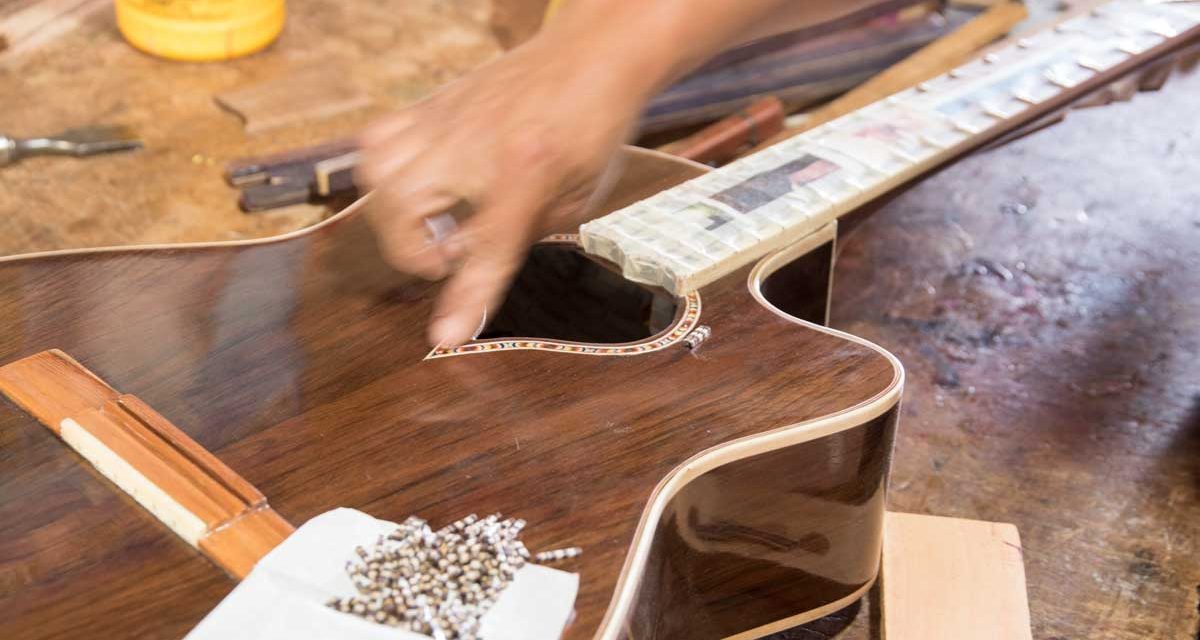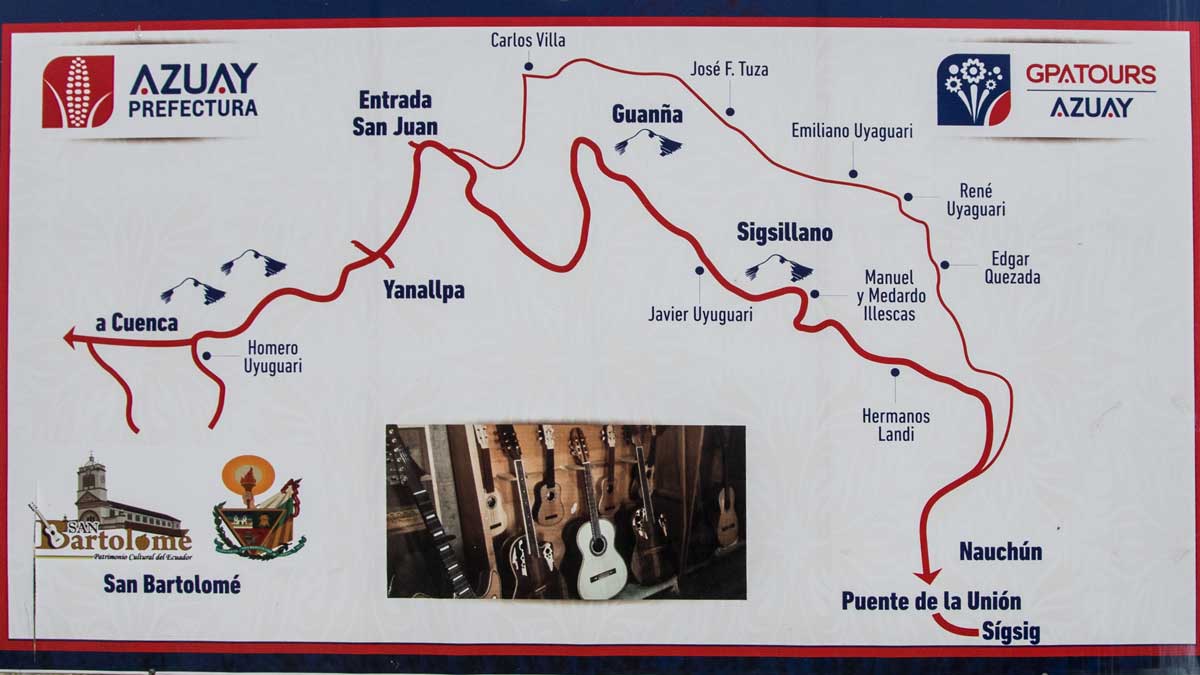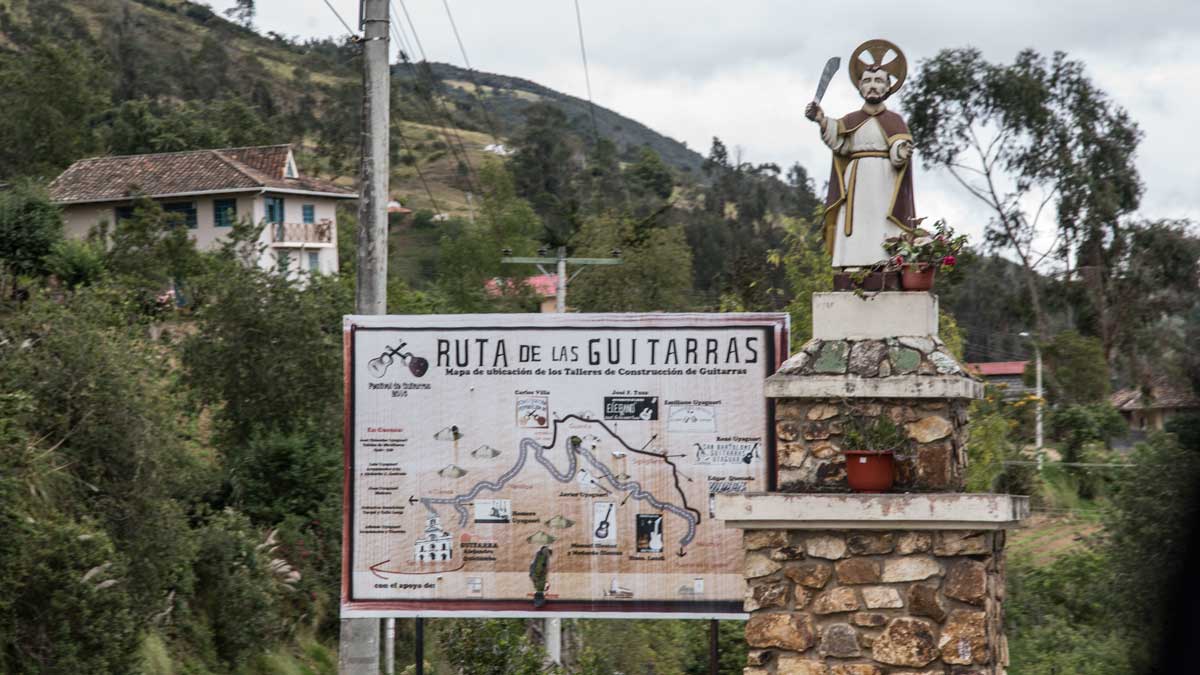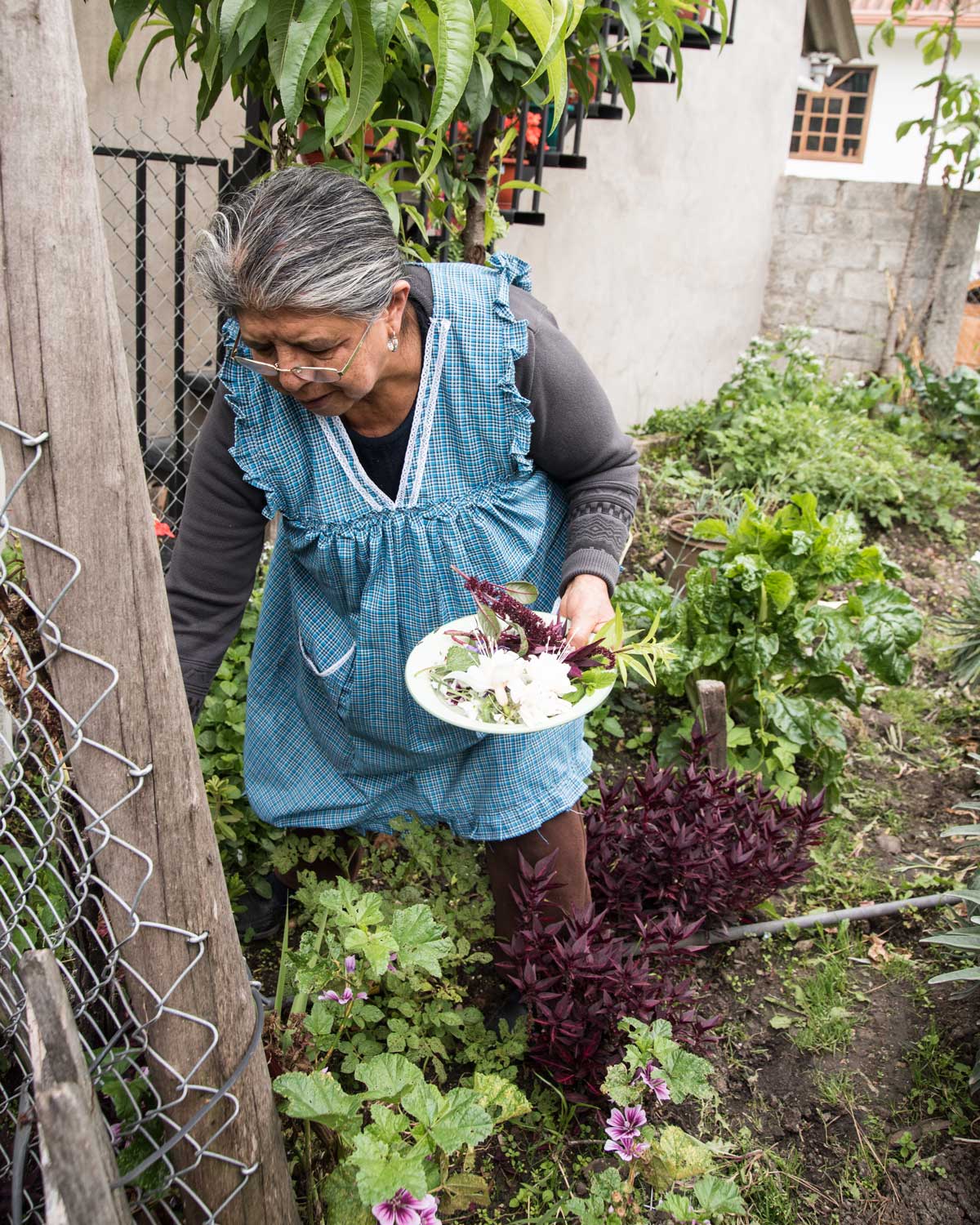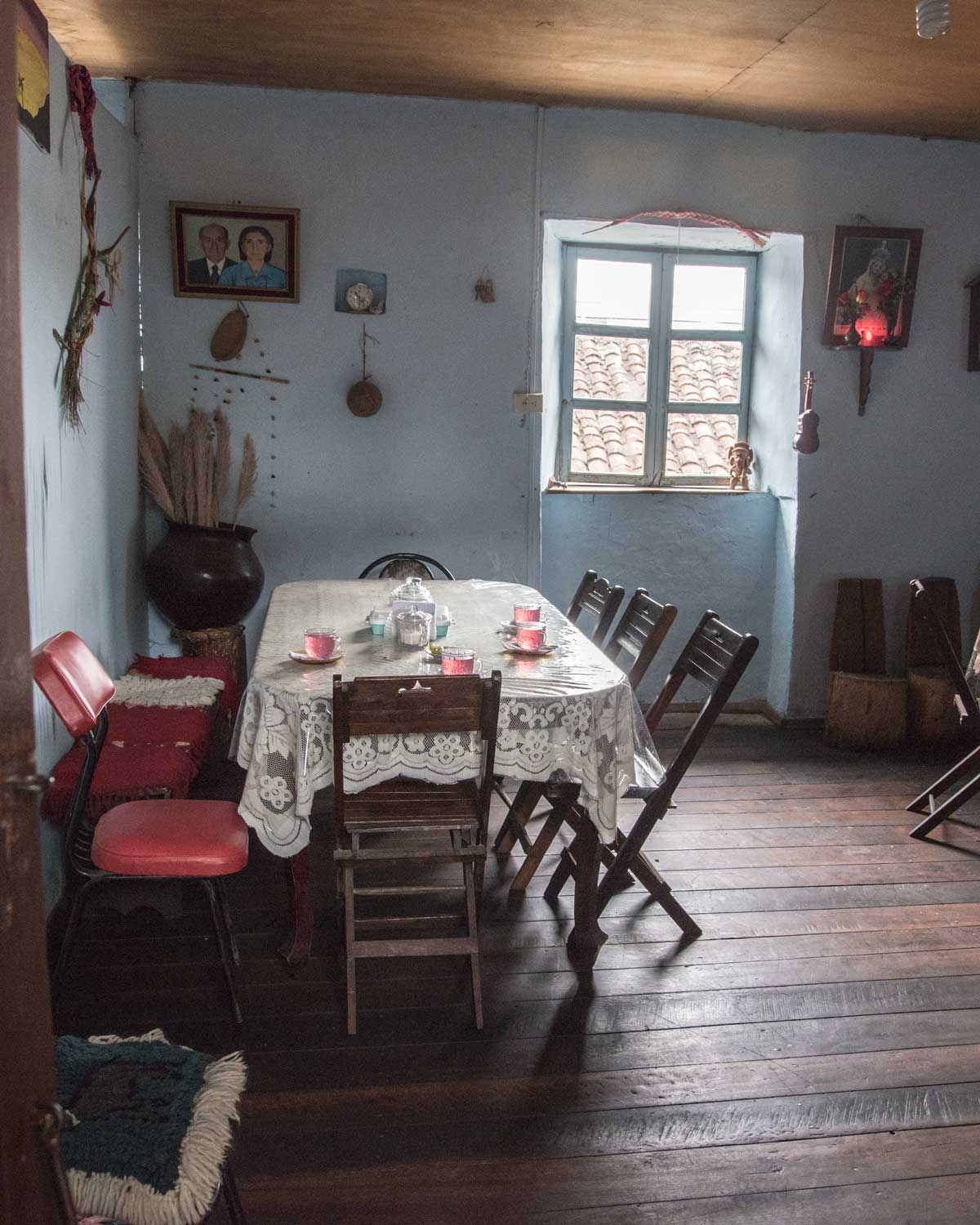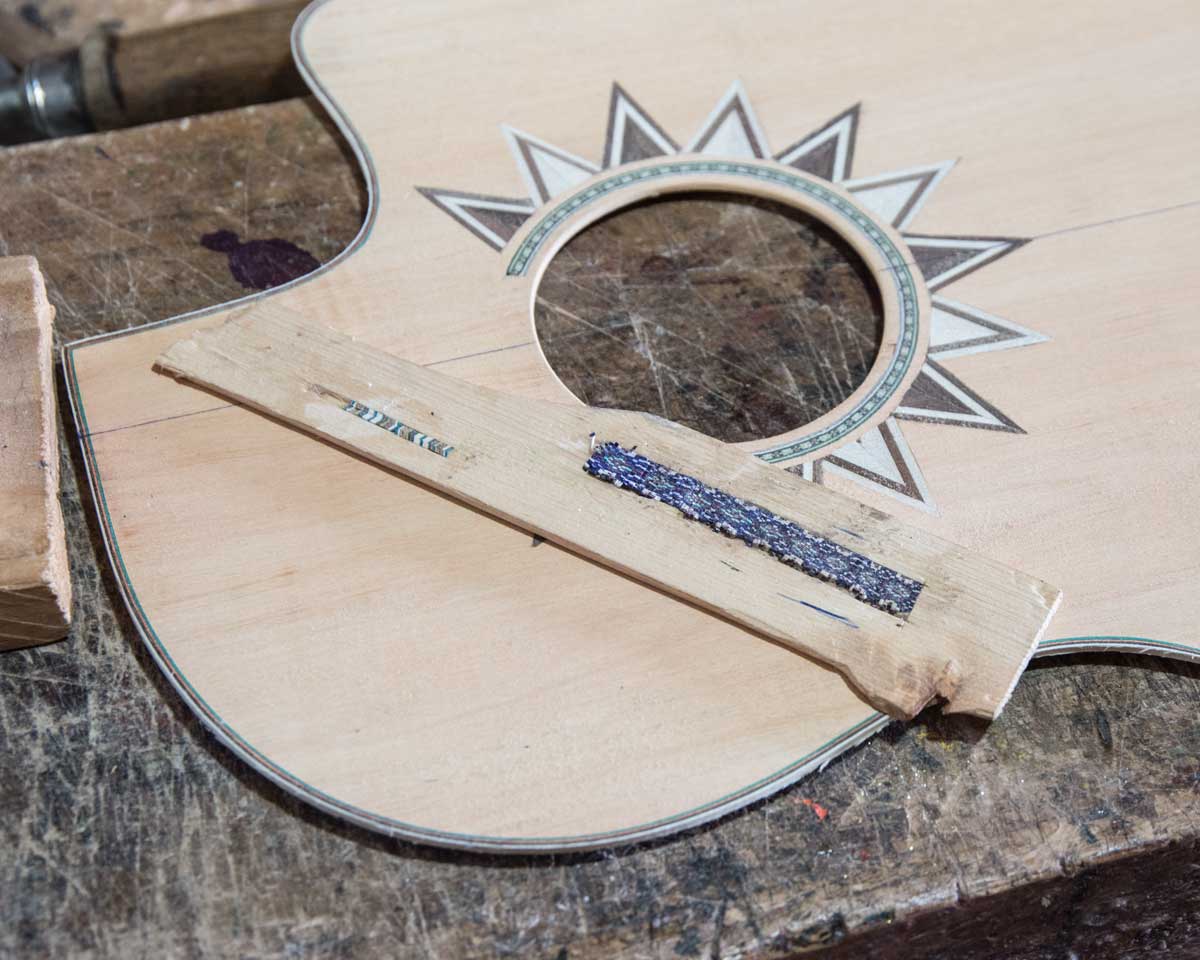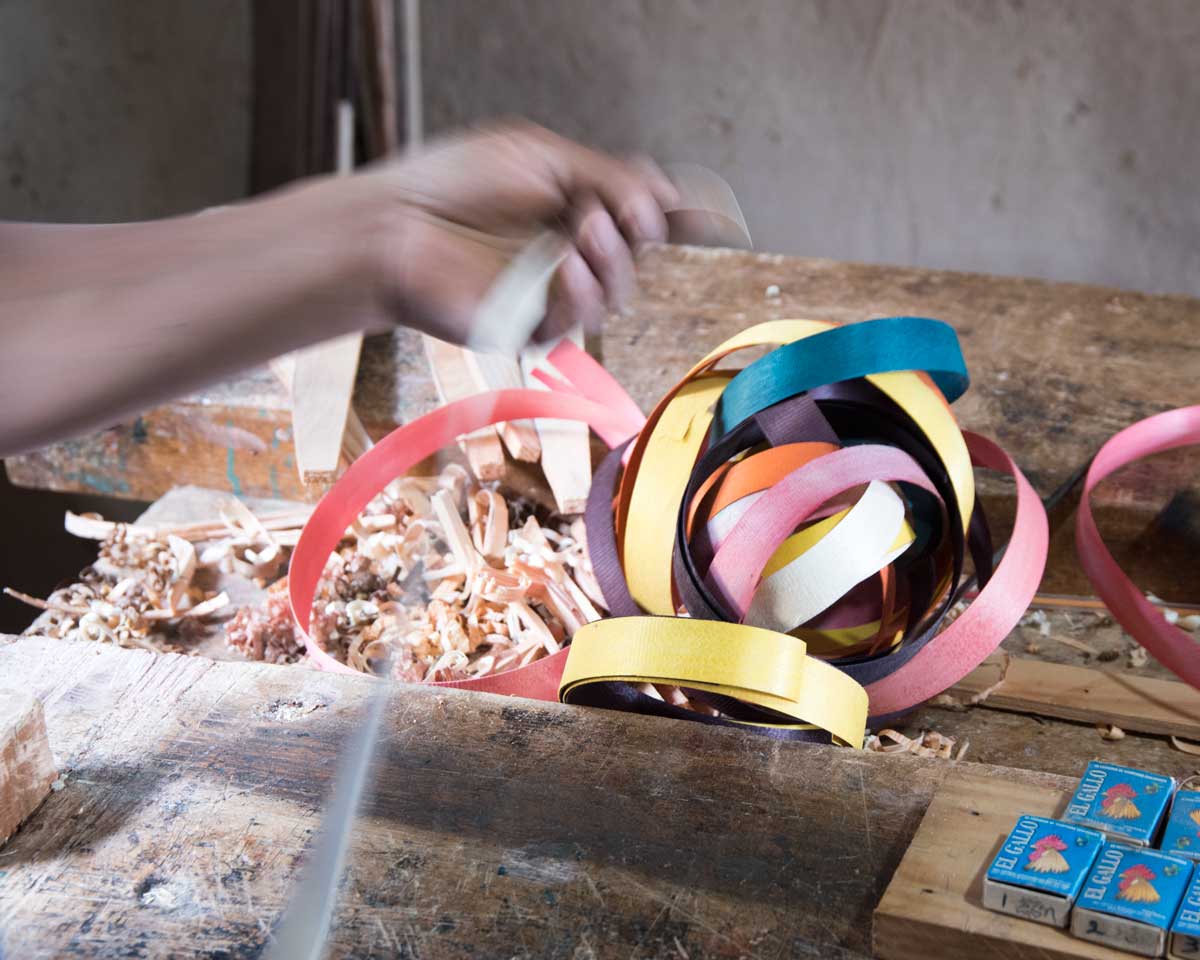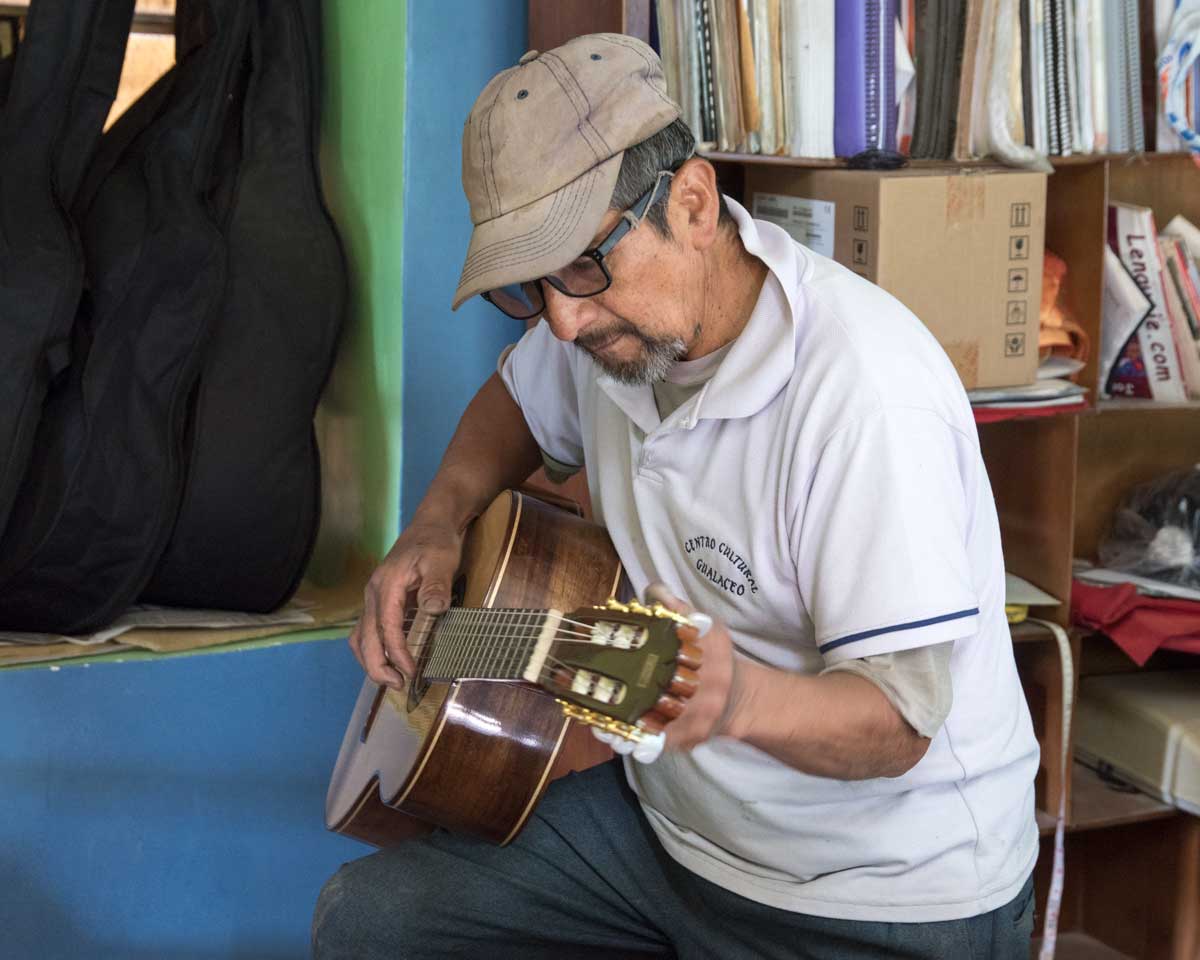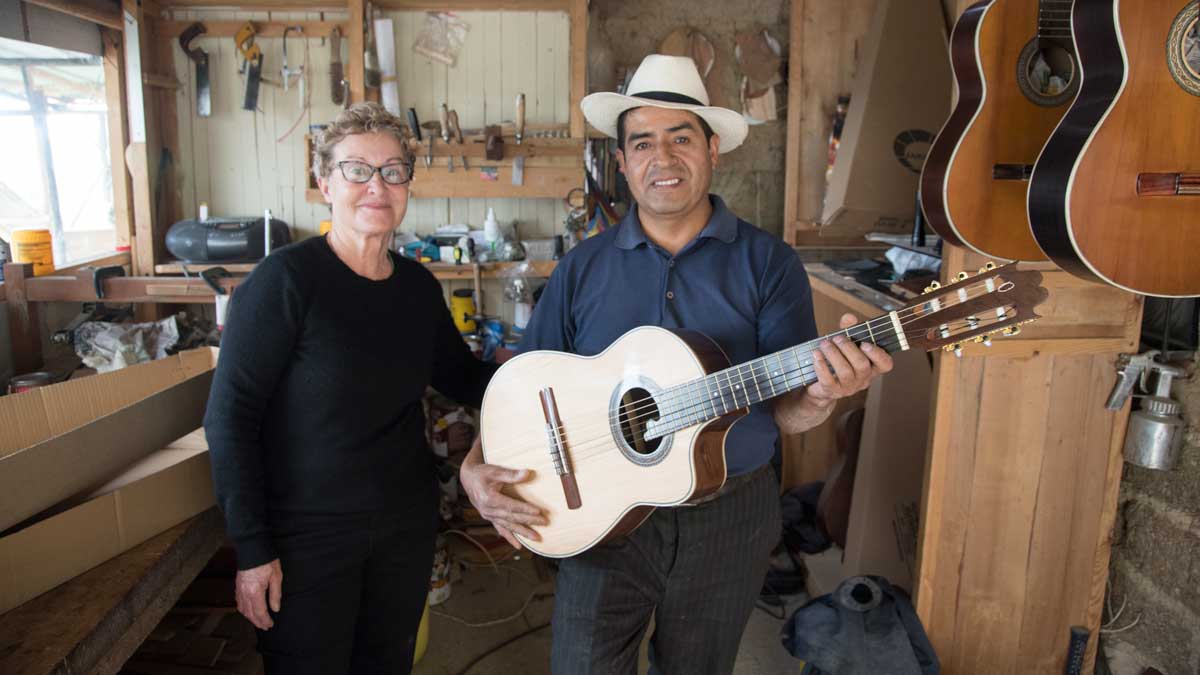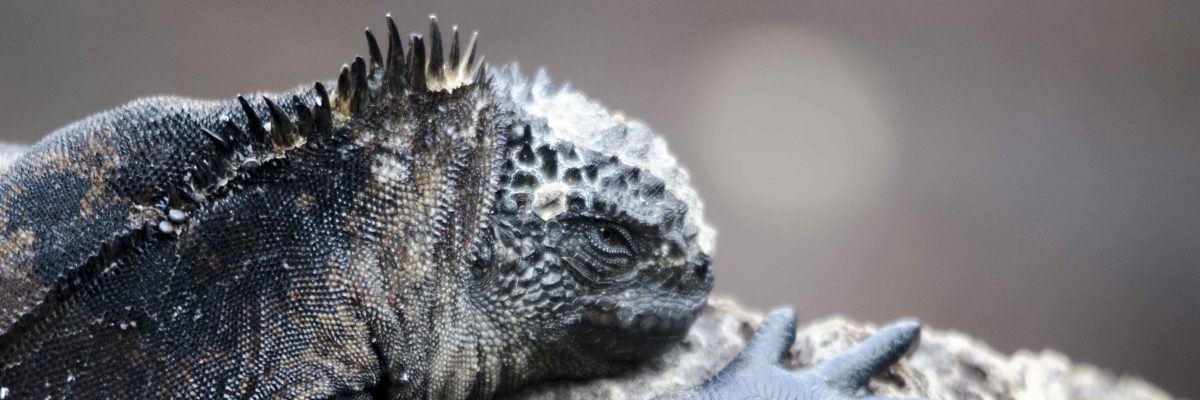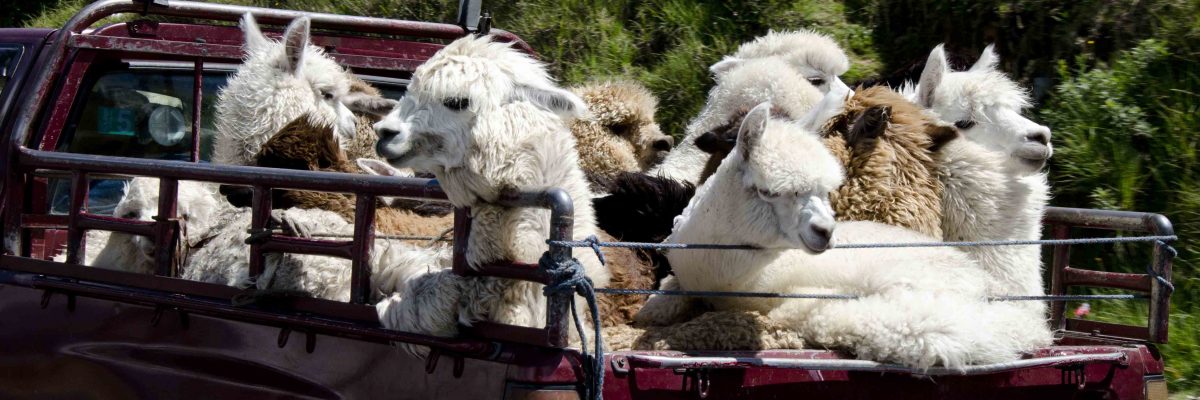As responsible travelers evolve, so do the stories we share.
This article is part of our living archive — trusted content we continue to care for.
First published on June 21, 2019 • Last updated on June 21, 2019.
A chance encounter with a guitar lover and fellow tourist in Cuenca led us to discover the Route of the Guitars, a little-known tourism route along the backroads of San Bartolome, Ecuador. While stringed instruments, including traditional guitars, requintos, charangos, and ukeleles, were on offer, the highlight of our day were the interactions with the different artists along the route.
Meeting Lynn
A few months ago, we were staying at La Cigale, a small hostel in historic Cuenca. This understated hotel with a restaurant and bar attracts an international clientele looking for a nice place to stay at a comfortable price. It’s super easy to strike up conversations with fellow travelers.
That’s how we met Lynn. She saved me from a conversation with another guest whose outlook on life was a little different than my own. An expat living in Vilcabamba, he was working on several different business interests all at the same time, all while trying to exude an earthy, granola vibe that didn’t quite fit his persona. Anyway, Lynn could see that I was trying to extricate myself from the conversation and politely interrupted our conversation to introduce herself.
Lynn is Canadian. But that isn’t what struck me. Instead, I felt the aura of a former military officer. Slim, fit, hair and a no-nonsense attitude made me wonder where she had served. I quickly learned that she had been a flight doctor in the Canadian Air Force.
The Quest for a Guitar
As we shared stories, we learned that Lynn was on a quest. She had come to Cuenca in search of a guitar. Although only a fair guitar player (her words, not mine), she wanted to find a well-made but not too expensive guitar to take back to Canada. As a world traveler, she wanted an instrument that would be easy to travel with, so not too large, and it needed to be made of quality woods with excellent craftsmanship.
During dinner, she told us how she had hoped to find a guitar in the small town of San Bartolomé. She had tried to a couple of different shops in Cuenca but none sold guitars that matched her demanding specifications. Again and again, shop owners suggested that she visit the Route of the Guitars where she could shop several workshops in a single day. As a solo traveler, the most affordable way would be by bus. However, the bus would require an hour and a half trip, each way. And she would still need to hire a local driver to take her to shops out in the countryside.
Scott and I are always game for an adventure. Therefore, we suggested hiring a driver for the day. Split three-way, the trip would be far more affordable for everyone. Moreover, if the hunt for a guitar was successful in half a day, we would be able to do a little more exploring. Being flexible would be key. Armed with my handy list of local phone numbers, I sent a WhatsApp message to a newly made friend and local guide who immediately put me in touch with Milton.
The Best Driver for Hire in Cuenca
Milton owns a transportation company that specializes in trips between Cuenca and Guayaquil. However, he sometimes uses his smaller vehicles to take tourists on day trips in and around Cuenca. He is not a guide. From time to time, driving is more important than guiding. After all, we knew where we needed to go but just needed a way to get there. Half an hour later, Milton and I had our plan figured out via WhatsApp.
The next morning, Milton was waiting outside our hostel in a neat and clean Jeep. We hopped on in and were quickly on our way.
Milton was as good as any tour guide, telling us the names of rivers as we passed and dropping little facts about names and places. We kept up a constant stream of conversation in Spanish with a few moments of translation to explain finer details to Lynn. In what seemed next to no time, we arrived in the small town of San Bartolomé.
San Bartolomé, Ecuador
This small Andean village competes with the better-known towns of Sigsig, Chordeleg, and Gualaceo for its share of tourism. With a tiny plaza embellished with musical instruments, neatly painted homes, and rolling mountainsides of patchwork farm fields, San Bartolome is picturesque.
A large statue of San Bartolome, the patron saint of leatherworkers and farmers, greeted us. It made me wonder how building handmade guitars became more popular than leatherworking. But popular it is. There are likely a dozen or more small workshops in the area, many of them nothing more than a small shed where a single artisan may build a few guitars a year.
Although our goal was guitar shopping, Milton suggested a stop at a corner store with no name. He pulled over on a quiet street corner in front of a building that looked more like a home than a tienda. He hollered a greeting past a large metal gate into the yard inside. A few minutes later, out came Doña Elmira.
Doña Elmira Makes Tea
A large, motherly woman clothed in a light blue dress pulled over practical pants and a warm sweater invited us into the inner sanctum of her small garden. As we admired the variety of flowering plants, she selected the best leaves and flowers from each one. She named a few: borage, lemon balm, geranium, and azalea.
After harvesting a colorful plateful, she slipped inside her kitchen. A few minutes later, she called us into the family room where she had laid a table with clear, glass teacups. Each cup was full of a gorgeous, pink tisane. These were cups of horchata, a local tea drunk for its calming properties.
As the drinks gently gave off delicate tendrils of steam, Doña Elmira placed a sugar bowl and a small plate of quartered limes in near reach. I squeezed the lime juice into the glass of hot liquid and watched the light pink turn a gorgeous, deep violet-purple. Simply beautiful.
Finding the Guitar Workshops
After tea, we walked into the main plaza and took photographs of the modern art guitars and the traditional church before jumping back into the car. If you’re like us, you probably thought that there would be at least one shop selling guitars in the village itself. You would be wrong. The guitar workshops were not to be found in town but in the outskirts. As with many artisans in Ecuador, artisan work is a part-time profession that accompanies the traditional work of a typical farm.
As we drove out of town on a steep, dirt road, Lynn began to realize how difficult her quest would have been had she arrived by bus. Her choices would have been to walk the dusty roads, hitchhike them, or hire a taxi in town. The latter would have been difficult midweek as our own driver seemed to be the only taxi-like vehicle in town.
Our first workshop stop was fairly short. The artist was not immediately available and the few guitars on display did not meet any of Lynn’s criteria. Though they appeared to be beautifully made, none were particularly small. Rather than wait, we said we would stop back by if the hunt was not fruitful further down the road.
The Uyaguari Workshops
Our second stop was more successful. There we met Sebastian Uyaguari. The Uyaguari name is renowned throughout the region for exemplary guitar making. Several of the workshops bear the Uyaguari name. Skills have passed from father to son since colonial times. Sebastian was the perfect host, not only showing his wide selection of guitars but also demonstrating the process of guitar making. He and Jorge, his apprentice, showed us how they made the intricate inlaid wood patterns and how they joined pieces of the guitar to make a harmonious whole.
The prettiest and best-made guitar that Lynn held that day was a well-worn requinto from Sebastian’s shop. A requinto is a small version of a classical guitar. It has 6 strings and a cut-away portion on the frame that allows the musician to more easily play higher frets. Sebastian said he was in the process of restoring the beautiful instrument. However, when Lynn asked the price, it was well over $1000, beyond her budget as a traveling minstrel. My impression was that Sebastian did not want to sell this guitar. He merely named a price he knew we would not be able to meet to prevent its sale. After asking why it cost so much, he admitted that it was one of the first guitars he had ever made.
So the quest continued. We stopped at a couple of other small workshops advertised only by a guitar hanging from the eaves outside. Very often, these hanging guitars were in the process of production, usually varnish or a paint drying. At one such stop, Lynn found a very small, student guitar made of Canadian pine and walnut. It fit her hands very well but when asked to play the guitar for her, the maker was unable to help us out. That’s when we learned the famous saying to the area:
In the house of the blacksmith, there are only wooden spoons.
In other words, blacksmiths never use metal tools as they never have time to make them for themselves. The same goes for the guitar makers of San Bartolemé. Many make guitars but don’t play them. More shockingly, this artisan didn’t know how to tune the guitar. Without a tool to help, nor could Lynn. So without knowing this pretty guitar’s full capabilities, Lynn decided to leave this compact beauty behind.
The Cayego Workshop
We were headed back to the first shop where we had started hoping the owner might be back from working the fields when we noticed another workshop. We stopped and asked a young woman if the shop was open. She pulled out her cell phone and called someone, asking us to wait while he arrived. We took the time to wander inside the workshop and saw a few guitars, most larger than Lynn was looking for. We began to have our doubts.
However, just as we decided this was the wrong shop, Lynn asked if there were any other guitars, just a little smaller. The young woman pointed to a corner where cardboard guitar boxes from Indonesia stood. As a group, we immediately cringed, thinking she would pull out a mass-market guitar made overseas. But no, from inside this box she pulled out a stunning example of a requinto.
At this point, a dark-haired, dancing eyed man hurried into the workshop. Dressed in striped trousers and a collared shirt, Gabriel Cayego, had to the look of an artist rather than a farmer. He immediately began to describe the workmanship that went into the making of the requinto hidden in the Indonesian box.
The front piece of this guitar glowed golden yellow from well-cured Canadian pine; its sides and back piece shone a dark walnut brown. Its neck was a richer gold made that came from Ecuadorian cedar. The fret piece was dark chonta, a hard palm wood from the Amazon basin. This beautiful blend of Canadian and Ecuadorian woods seemed to call to Lynn. She put out her hands to hold this warm guitar and started to fall in love.
Rather than play it herself, she handed it back to Gabriel and asked him to play. He strummed the strings and, as if he had been Cupid aiming a bow instead of a guitar, the arrow struck. Lynn knew this guitar would be hers.
After that, the business of coming to a price took very little time. The search for a perfect guitar had ended!

